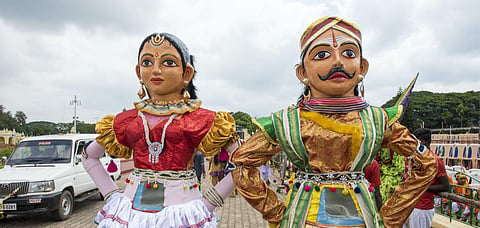
- Destinations
- Experiences
- Stay
- What's new
- Editor’s Picks
- Responsible Tourism
- CampaignsCampaigns
- Subscribe

Jagdalpur
Although called Bastar Dussehra, it has got nothing to do with the story of Ram&rsquos win over Ravana. The festival and fair lasts over 45 days generally. It is mainly held in honour of Goddess Danteshwari (the guardian deity of the tribal belt of Bastar in Chhattisgarh) and other divinities. Local history says the festival began in the 15th century after the Kakatiya king Purushottam Deo returned from a pilgrimage to Puri in Odisha. There are many rituals associated with this festival, including chariot processions, the visit to Jagdalpur by various deities of Bastar, the tribal chieftains&rsquo conference, and the thanksgiving ceremonies. The nearest airport is in Raipur, less than 300km by road from Jagdalpur.
Kolkata
In Kolkata (or wherever Durga Puja is celebrated), Dussehra is known as Vijaya Dashami. It marks the final day of Durga Puja when the idols of Goddess Durga and her four children are taken to the river for immersion. Of the many rituals observed on this day, the most popular is the one where married women offer vermillion and sweets to the goddess, and then smear each other with the vermillion. In Kolkata, the deities are taken out in a huge procession and carried to the Hooghly (Ganga) river. One of the best ways to watch the immersion is by hiring boats.
Kota
Kota in Rajasthan is known for its Dussehra Mela. On the day of Dussehra, religious functions are held in the royal palace since morning. Then the king and other members of the royal family travel in a colourful procession to the fair ground.
Towering effigies of Ravana, Kumbhakaran, and Meghnad are kept ready and the king inaugurates the celebration by igniting the effigies. The firecrackers stuffed inside the effigies burst and light up the sky. A huge fair is held during this time, including a cattle fair. The Kota municipality organises a cultural programme too. You can browse through local handicrafts and sample local cuisine at the fair.
Kullu
See all the leading deities of Himachal Pradesh assemble in Kullu town (nearly 40km away from Manali) during Dussehra to pay their respect to Lord Raghunath. The festival begins on the day of Dussehra and continues for seven days. The deities arrive in their own palanquins and camp in the Dhalpur Maidan. Some come from remote corners, the entourage&mdashconsisting of the palanquin bearers, the musicians, priests and other attendants&mdashmaking the journey over several days and on foot.
Among of the interesting rituals that take place during this time are the Rathayatra of Lord Raghunath, the procession of the gods around town, and the meetings that take place between the various deities (conducted by the officiating priests) where they exchange news and views&mdashdon&rsquot be surprised if you find some of them engaged in heated exchanges.
Kullu town is immersed in festive cheer and a big fair is held at the Dhalpur Maidan. Enjoy the cultural programmes and shop for locally made handicrafts, especially the signature caps and shawls. It is best to book accommodation in advance as Kullu Dussehra draws a large number of visitors from home and abroad.
Mysore
Known as Dasara, this is Mysore&rsquos most popular festival. Held at the end of the nine-day Navaratri festival, it marks the day of victory when Goddess Chamundeswari defeated the demon Mahishasura. The illuminated Mysore Palace looks like a fairyland by night.
After the goddess is worshipped in the palace by the royal family, she is taken out in a grand procession. The goddess is placed in a golden howdah atop a decorated elephant. The procession, known as jamboo savari, consists of grand tableaus, musical and dance performances by various artists, enactment of local folklores, decorated elephants, giant puppets, horses, and more. The procession starts from the royal palace and concludes at the Banni Mantap.
A torch-light parade is held here in the evening and a huge fair is held at the Exhibition Ground opposite the palace. Cultural and sporting events are also organised during the 10-day festival.
